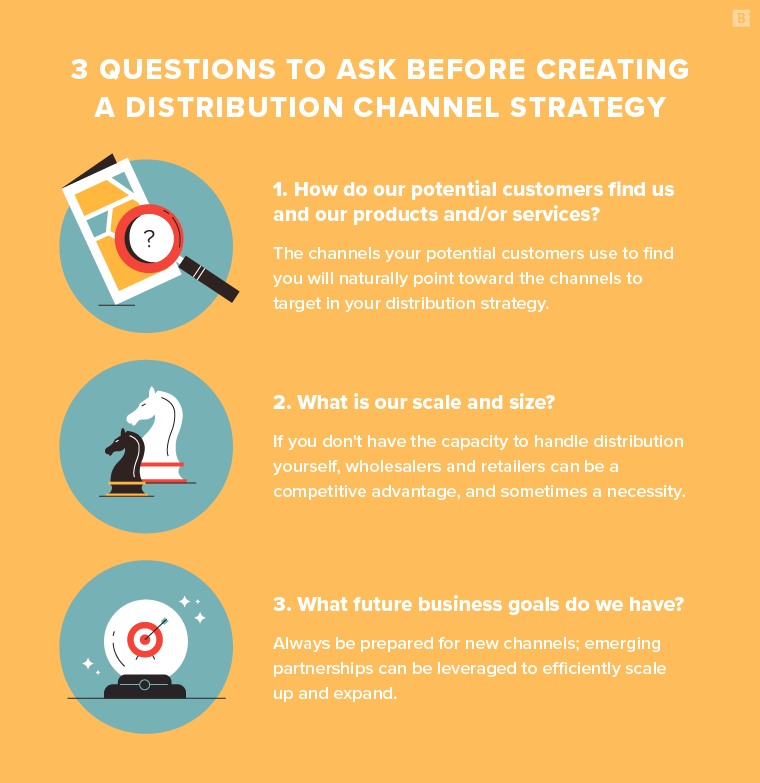Say you have a great product or service that meets a pressing need.
That’s all well and good — but a million-dollar idea has no path to becoming a million-dollar revenue-generator if you can’t get your products or services in front of consumers and your target market. This is where distribution channel strategies come into play to offer solutions.
A well-planned distribution channel strategy is specifically designed to increase the sales of your products or services as they enter the market. At the end of the day, the fundamental problem most businesses face is not how to develop the product or service, but how to market and sell it to the public.
It may seem easy in the age of e-commerce and social media, but without a defined distribution channel strategy, you stand less of a chance of reaching consumers or making an impact with your target audiences.
Let’s explore the finer points of crafting a distribution channel strategy, the benefits of various channels and what you can do to fine-tune your approach.

What Is a Distribution Channel Strategy?
Fundamentally, distribution is the process of getting a product or service in front of the end consumer. The buying and selling of goods and services may appear fairly simple and linear, but it never is. Distribution is a multifaceted affair that requires strategy and partners.
There are different levels of distribution, including direct and indirect channels. The more intermediaries, the more levels. A zero-level channel would entail a producer selling directly to end customers, whereas a three-level channel includes selling to a distributor and then a retailer before reaching end users.
Consider all the hands a smartphone passes through before reaching the end consumer. Not only is the manufacturer involved, but also potentially a wholesaler, retailer, broker agent or another entity.
There are two basic types of distribution channels:
- Direct: Consumers buy the product or service directly from your business, whether through a physical storefront or an e-commerce website.
- Indirect: Consumers buy the product or service through an intermediary, like a big-box retailer you have distribution agreements with or a broker agent you partner with.
Channels can also be defined as short or long. A short channel involves the fewest steps possible between producer and customer, like with direct marketing. A long channel includes other intermediaries like wholesalers and retailers.
Distribution Channel Strategy vs. Supply Chain Management
An important distinction to make is that channel distribution strategy does not equal supply chain management. Supply chain management involves the sourcing and routing of materials and products through the manufacturing and distribution processes. Channel distribution is often the final stage of the chain —– delivering final products to end users.
Channel distribution is solely about getting your product to the market, whereas supply chain management relates to sourcing the parts or materials that make your product as well as delivering final products to where they need to be.
Subscribe to
The Content Marketer
Get weekly insights, advice and opinions about all things digital marketing.
Thank you for subscribing to The Content Marketer!
How to Develop a Distribution Channel Strategy
When crafting your distribution channel strategy, it is imperative to include a comprehensive plan on how to reconcile your inventory, ensuring seamless management of stock levels to meet customer demands and avoid potential issues such as overstocking or stockouts, ask yourself the following three questions to understand your needs, capacity, limitations and goals:
1. How Do Our Potential Customers Find Us and Our Products and/or Services?
The channels your potential customers use to find you will naturally point toward the channels to target in your distribution strategy. You need to plan your demand better, so analyze how social media, search engines, direct marketing, partner sales, industry recommendations and other channels perform in generating customers.
Customers of a millennial beauty products company will have a much different purchasing path than a B2B buyer of network infrastructure. Identifying your main channels is a bit like looking at the channels with your highest level of brand awareness, and then fitting your strategy to maximize performance in those channels.
2. What Is Our Scale and Size?
One reason why long channels exist is that not every business has the relationships or expertise to handle logistics. An energy drink company might develop a new formula that tests great with consumers but lacks the means to ship the product to nutrition stores nationally. That’s where relationships with distributors, wholesalers and retailers become a competitive advantage, and sometimes a necessity.
Distributors can fulfill orders for whole pallets of energy drinks, while wholesalers can find retail buyers to get the product in stores. Established businesses that benefit from enterprise-scale are often able to condense channels or acquire or integrate horizontal business units to take care of logistics and other distribution needs.
3. What Future Business Goals Do We Have?
Always be prepared for new channels.
If your aim is to expand into a new market or territory, determining your channel strategy is an integral part of defining your over go-to-market strategy. If you have no relationships with a regional retailer, your product launch may suffer when trying to grow in that locality. Channel partners, however, can be leveraged to efficiently scale up and expand.
On the other hand, opening up more direct channels may be your best option for increasing brand awareness or profit per sale. Long channels mean higher costs and more cooks in the kitchen; a direct channel can lead to a better customer experience or brand impression.
Distribution Channel Types
While direct channels of distribution may seem like the obvious choice, they are not always the right option or even a possibility. Companies in several industries have to comply with various regulations that govern how products and services reach consumers, such as those in finance, food and beverage or medical devices.
Let’s explore some of the most common channels and how to judge whether they are right for your marketing mix:

Retail
Need a way to reach more consumers? Placement in a retail store is your best bet for broadening your customer base. But you can’t just walk up to the nearest Walmart or Target and ask for them to feature your product on their shelves. Retailers buy from distributors and wholesalers, meaning you’ll need to pursue longer channels.
However, regional or local chains may be more willing to negotiate on a personal basis — i.e., buying inventory straight from you or your manufacturer. Retail is clearly best for companies that sell physical goods, but just be aware that competition will be high. If you go with a big-box chain, you might be going up against the biggest brand names in the industry. Retailers won’t work repeatedly with businesses that don’t perform.
Direct Marketing
Want to cut out the middlemen and reach out to consumers yourself? A direct marketing campaign can help connect you with potential customers, as well as provide them the means to make a purchase directly. Such channel strategies often manifest as product catalogs, marketing calls, emails or face-to-face sales. While direct channels mean greater engagement and profit, they also require more resources and effort from the brand to manage direct marketing.
Dealer Network
Don’t have an especially large or skilled sales force? You can essentially outsource those functions to a network of dealers, brokers and agents who do the selling for you. This arrangement is particularly advantageous if you have a specialized product or lack deep industry connections.
Insurance companies, for example, often rely on a vast network of brokers to find customers and sell them policies offered by the business. A dealer network still needs support, however, as you’ll need to provide agents with literature, marketing collateral and other resources. You’ll also need to negotiate commissions and fees.
Website Store
The advent of the internet age has opened up a whole new channel for B2C and B2B brands alike, as well as large and small companies. Startups without channel relationships can sell directly to consumers through inbound marketing, cultivating brand loyalty and lowering their go-to-market costs.
Meanwhile, established companies can open up new revenue streams with a website store that long-time brand evangelists can use. Highlighting your website store through messaging, content and social media can help supercharge your marketing. For instance, without the cost of a long channel, you may be able to offer special discounts or promotions on sales that can be traced from a Facebook or Twitter link.
Wholesale Distribution
Long channels of distribution are not innately bad. In fact, they can deliver tangible competitive advantages when working with the right wholesale or distribution partners. What’s the difference? Distributors are basically wholesalers that offer a greater scope of services.
Wholesalers will purchase and resell your goods in bulk, fulfilling orders to retailers — distributors do all that and more as an effective sales agent of the company. Wholesalers are in it for their own business and margins, whereas distributors work much more closely on a strategic level. Both can help lift your brand’s profile and sales.
E-Commerce Site
Online markets like Amazon, Zappos and Etsy have become go-to channels for sellers of physical goods. Merchants can leverage the established base of online customers as well as marketplace tools, allowing them to reach end users with high intent. E-commerce sites operate in a different way than direct online stores, so you’ll want to ensure your ads and product pages are branded in a way that fosters a consistent customer experience.
Value-Add Resellers
VARs, as they’re called, buy inventory from companies, and then make upgrades or package it with their own services. The symbiotic relationship can help you meet goals like expanding your footprint or securing recurring revenue from a VAR buyer. This exclusive channel of distribution works particularly well for companies that have a specialized product, as it’s not about casting the widest net.
What Is the Right Mix of Channels?
In reality, most businesses will employ a multi-channel marketing mix that makes use of both direct and indirect channels, when available to them. The same craft brewery that has to work with distributors, wholesalers and retailers can also sell to customers directly at an on-site taproom. Even agricultural producers can sell at farmer’s markets in addition to working with distributors that get fresh produce to the groceries across the nation.
When sitting down to hammer out a distribution strategy, always be open to the different combinations that can be made with direct and indirect channels. However, just be sure that conflicts will not arise. Retailers may have certain stipulations for working with them, as other intermediaries would. Also be sure to not spread yourself too thin, especially if you’re just starting out. If you introduce new channels into your mix, devise a plan that gradually integrates them, and sets standards and expectations for performance and costs.
Keep all this in mind when developing your strategy. But always be aware that unique factors like the industry in which you operate will be influential to your decision-making.
Editor’s Note: Updated June 2022.





